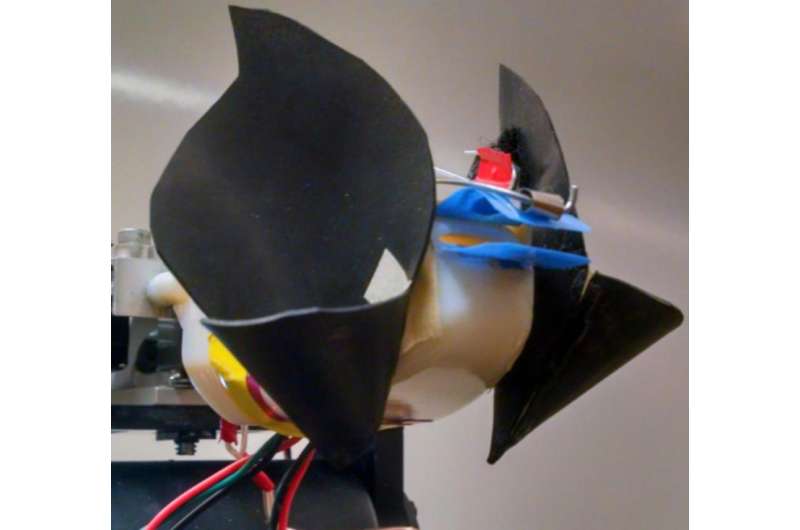Robotic sonar system inspired by bats

Rolf Mueller, an associate professor of mechanical engineering in the College of Engineering at Virginia Tech, has developed a prototype of a dynamic sonar system inspired by horseshoe bats.
The prototype was presented Wednesday (May 20) at the Acoustical Society of America meeting in Pittsburgh, Pennsylvania. The principles used in its design could eventually lead to sonar systems much more effective than the best arrays available today.
Because bats use a form of biological sonar called echolocation to navigate and hunt in the dark, they are natural models for man-made sonar systems.
Horseshoe bats' sonar is especially sophisticated.
"They among the most maneuverable fliers, and they hunt in the most confined, complicated spaces," Mueller said.
To pick out a moth's fluttering wings from the canopy of leaves in a dense thicket, for example, horseshoe bats have the ability to adjust their sonar pulses to pick out small frequency shifts caused by the wing motion of their prey.
The bats emit ultrasonic pulses through their noses, which are outfitted with intricate folds of soft tissue called noseleaves.
The noseleaves act like megaphones to amplify the sound, but they also modify their shape to fine-tune the characteristics of the emitted pulses.
The bats' ears, which receive the incoming echoes, are also dynamic, adjusting their shape and angle to filter the sound more efficiently. These precise adjustments happen within one tenth of a second—about three times faster than a human can blink his eye.
These adjustments are part of what allow the bats to get more detailed data from just two receivers than modern naval sonar systems can collect with several hundreds.
Mueller's prototype is the first sonar system that—like the horseshoe bat—has both a dynamic emitter and dynamic receivers.
To develop their model, Mueller and his team studied a colony of about 30 bats. They tracked the movements of their ears and noseleaves with a combination of high-speed video, ultrasonic microphone arrays, and laser Doppler vibrometry.
The vibrometer directs a laser beam at a moving object, and uses the Doppler shift of the reflected beam to measure the amplitude and frequency of the object's vibration—much the same way that the bats use the Doppler shift of its reflected ultrasound pulses to track their prey.
This data allowed Mueller to build three-dimensional computer models of the bats' ears and noseleaves, and study both their structure and their key movements.
"Our goal is to reproduce all the features that we are sure have a function, or that we think might have a function. Then we'll trim it down," Mueller said.
The current prototype is two and a half times the size of a common horseshoe bat species. Four motors control the ears and noseleaves, which are made of flexible rubber. The motors can carry out these adjustments about as fast as the real bat.
In nature, the bats' flight adds an extra layer of complexity: to compensate for their own motion, bats adjust the frequency their outgoing sonar pulses so that the reflected ultrasound will fall in the optimum range for detection. To study how to replicate this capability, Mueller plans to mount his prototype system on a small drone.
More information: Presentation #3pAB2, "A design for a biomiometic dynamic sonar head," by Phllip Caspers, Yanqing Fu and Rolf Müller will be take place on Wednesday, May 20, 2015, at 1:45 PM in Rivers. The abstract can be found by searching for the presentation number here: asa2015spring.abstractcentral.com/planner.jsp
Provided by Virginia Tech



















